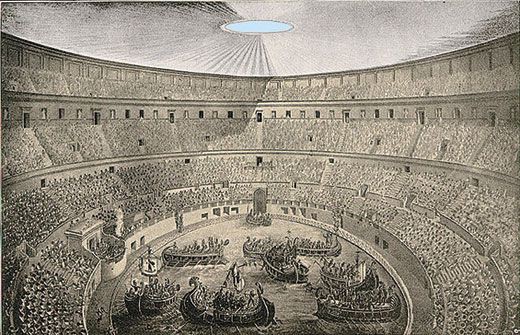
Rome wasn’t built in a day. But one of its most renowned attractions could be returned to its first-century glory in just two years — or at least, part of one of its most famous attractions could be. In our time, the Colosseum has long been a major Roman tourist destination–one that lacks even a proper floor. Visitors today see right through to its underground hypogeum, an impressive mechanical labyrinth used to convey gladiators into the arena, as well as a variety of other performers, willing and unwilling, human and otherwise. “Eyewitnesses describe how animals appeared suddenly from below, as if by magic, sometimes apparently launched high into the air,” writes Smithsonian‘s Tom Mueller.
“The hypogeum allowed the organizers of the games to create surprises and build suspense,” the German Archaeological Institute in Rome’s Heinz-Jürgen Beste tells Mueller. “A hunter in the arena wouldn’t know where the next lion would appear, or whether two or three lions might emerge instead of just one.”
Now, the Italian government has announced plans to return the element of surprise to the Colosseum with a restoration of its elaborate “retractable floor.” This has drawn the attention of media concerned with history and travel, but also the world of architecture and design. With €10 million already pledged by the state, the worldwide call is out for architectural proposals, due by February 1 of this year for a tentative completion date of 2023.

The Colosseum, which once seated 50,000 spectators, hasn’t put on a battle since the fifth century. The hypogeum’s long exposure to the elements means that any architectural firm eager to take on this project will have its work cut out for it. Few restorations could demand the striking of a trickier balance between historical faithfulness and modern functionality. Whatever design gets selected, its trap doors and hidden elevators will be employed for rather different entertainments than, say, the death matches between slaves and beasts to which so many ancient Romans thrilled. The Italian government intends to use the Colosseum’s new floor to put on theater productions and concerts – which should turn it into an even more popular attraction when we can all once again go to the theater, concerts, and indeed Italy.
Related Content:
Rome Reborn: Take a Virtual Tour of Ancient Rome, Circa 320 C.E.
Building the Colosseum: The Icon of Rome
Magnificent Ancient Roman Mosaic Floor Unearthed in Verona, Italy
Based in Seoul, Colin Marshall writes and broadcasts on cities, language, and culture. His projects include the Substack newsletter Books on Cities, the book The Stateless City: a Walk through 21st-Century Los Angeles and the video series The City in Cinema. Follow him on Twitter at @colinmarshall, on Facebook, or on Instagram.
Rome’s Colosseum Will Get a New Retractable Floor by 2023 — Just as It Had in Ancient Times is a post from: Open Culture. Follow us on Facebook, Twitter, and Google Plus, or get our Daily Email. And don't miss our big collections of Free Online Courses, Free Online Movies, Free eBooks, Free Audio Books, Free Foreign Language Lessons, and MOOCs.
from Open Culture https://ift.tt/2JP8v1Y
via Ilumina
Comments
Post a Comment